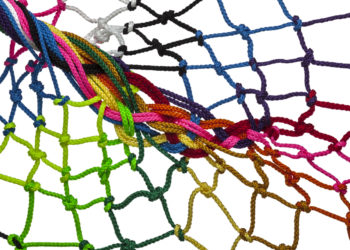Last Thursday, news of Elsevier’s acquisition of Aries Systems broke, and the reactions were varied. Some boasted that they’d predicted moves along these lines. Others speculated about a possible boycott of Elsevier and Aries journals. And some decried the lack of “independent” options in the space Aries helped to create — online manuscript submission and management systems.

There also seemed to be echoes, one of which related to last December’s announcement by PLOS that they were abandoning the effort to create their own manuscript submission system (Aperta) after years of development. PLOS uses Aries Systems, so this was tantamount to an endorsement of Aries in practical and symbolic terms. Now, we have Elsevier, which developed its own manuscript submission and tracking system called Evise — and used it in a limited way after lackluster reception by editors and authors — acquiring Aries Systems, ostensibly to improve their ability to handle important elements of the publishing workflow.
There was also an echo of Wiley’s acquisition of Atypon in 2016, where a publisher acquires a privately held family-owned company delivering business critical services to other publishers, which brings to light all the data protection and business continuity concerns you’d imagine. By emphasizing oversight and firewalls, Elsevier and Aries seem to be following the Wiley-Atypon lead to assuage customer concerns.
Manuscript submission and tracking systems are extremely complex to build and maintain, especially in multi-tenant deployments. With the increasingly common practice of journal cascades, these systems have only become more complex (Elsevier filed what they claim is a defensive patent in this area years ago to prevent another company from patenting a narrow set of cases around manuscript cascading). Key parts of Elsevier have been using Aries Systems’ Editorial Manager® for many years, when the company adopted it by default when it acquired Cell Press in 1999.
Manuscript submission and tracking systems are also among the most-hated types of systems for academics, for a few key reasons — they are usually the only publishing systems that academics have to deal with (they’d probably also hate publishers’ other systems); submission requirements are complex and demanding; it’s psychologically demeaning to submit papers to an uncaring system (mailing a packet of manuscripts was simpler and had more positive feedback mechanisms, from the photocopy station to the post office staff); and system interfaces aren’t as smooth and sophisticated as most of the rest of their online experiences. Manuscript systems are perceived as uncaring, unforgiving, and ungainly by most users.
It’s easy to forget that even distinguished researchers spend much of their time using the superbly designed interfaces of Amazon, Netflix, and Google. The consumer Internet has raised the bar for all software and user interface development, even the relatively obscure software used in highly specialized areas of research and publishing.
The business fundamentals of the deal are interesting to contemplate. Publishers have benefited tremendously over the past 50-75 years from a robust subscription model, which provides recurring revenues, which I’ve argued are the best kind of revenues for a variety of reasons. Open access pressures have threatened these stable revenue sources, replacing recurring revenues with the much less attractive non-recurring revenues of article processing charges (APCs). This may have been a factor in the poor market response to the attempted Springer-Nature IPO earlier this year.
Elsevier’s acquisitions have been paving a path into data and analytics for a while now (Mendeley, Plum), with some strong content-source positioning (bePress and SSRN) adding even more to their growing portfolio of interesting strategic products. None has had the combination of strong recurring revenues and high switching costs of Aries Systems, however, which sets this acquisition apart in my mind.
Changing manuscript systems can be among the more jarring transitions a publisher can make. Platform migrations pale by comparison, because editorial functions have much touchier stakeholders, most of whom are more than willing to call and complain if there is even the slightest problem. High switching costs make it highly likely that any immediate negative reactions to this news will amount to grumbling but little movement, giving Elsevier and Aries time to prove that they can pull it off. For instance, based on the rumor mill, many of Atypon’s larger customers were upset to learn of Wiley’s acquisition of their platform provider and threatened a rebellion, but they are now renewing their contracts after the new entity proved it could execute and maintain the proper arm’s length arrangement. A manuscript system provider probably has a longer time horizon during which it can prove itself.
In speaking with various people in the days following the announcement, a number mentioned that there seems to be a rhythm to these kinds of acquisitions — a period immediately post-acquisition of quiescence and status quo, where the business is run carefully and with its priorities intact; a period 2-5 years after the acquisition where the strategic imperatives that informed the acquisition begin to impose themselves on the operation, often in a disruptive way that can make customers feel sidelined; and then after 5 years, a new status quo emerges that is a hybrid of the original product, the acquiring firm’s priorities, and new imperatives coming up from customer angst, emerging needs, and a reaction to market performance.
Even given the benefits of recurring revenues, Aries Systems seems to be relatively small acquisition for Elsevier, with online sources estimating its annual revenues as $5-6 million. For a multi-billion-dollar company, assuming they paid a decent multiple via a competitive process (terms were not disclosed), the expenditure was probably quite tolerable given the strategic positioning of the entity. This likely means there’s also a decent amount of money and resources available for improving and enhancing the underlying technology.
Even if Elsevier doesn’t grow significantly in revenues with this acquisition, it grows significantly in gravitational pull and centrality.
Even if Elsevier doesn’t grow significantly in revenues with this acquisition, it grows significantly in gravitational pull and centrality. Thousands of papers flow through Editorial Manager every day. The only other comparably positioned manuscript system is ScholarOne, owned by Clarivate. There seems to be an arms race between Clarivate and Elsevier when it comes to data and centrality. This move puts Elsevier on a better footing for the market confrontations that may lie ahead.
Interface and analytics development is also key to the next generation of manuscript systems. Reporting is a key weakness of these systems, with editorial staff often tasked with downloading, parsing, and assembling reports for editors, boards, and management, wasting hours every month or quarter when computers could do it more easily. While the data flows from Aries Systems into Elsevier may be firewalled, the data flows from Elsevier’s other offerings into Aries Systems may be robust, allowing for a next-generation of editorial reporting. Aries Systems will also benefit from a wave of development resources to support this potentiality.
There is almost certainly a timing aspect to this news. Aries Systems was started by Lyndon and Sandra Holmes in 1986. Manuscript systems were at first modest PC-based systems, but as bandwidth and computing power improved, online submissions made these types of systems truly indispensable for most publishers, and Aries was well-positioned to take advantage. It provides services to PLOS, Springer Nature, Elsevier itself, and dozens of other commercial and non-profit publishers. But after 32 years building the company, its longevity beyond the founders certainly had to be a question at hand. By selling to a company adept at acquisitions and integrations, Aries’ leadership has likely ensured that their work will endure.
Holmes will stay on as an advisor to the company, which will remain based just north of Boston, having recently moved to new quarters in the area. A Customer Advisory Board will be created to help guide the organization, which will firewall its data from Elsevier in a manner akin to how Atypon had to firewall its data from Wiley when it was acquired.
In the grander scheme, this acquisition feels like more of the same when it comes to bigger fish gobbling up smaller fish. We are in a business environment where organic growth is difficult and content devalued, so the natural business response is to seek recurring revenues from service offerings while leveraging and replenishing strategic data storehouses. Independent entities are going to continue to be gobbled up as larger firms seek growth and diversified revenue streams. Consolidation is the tenor of the times. The difference with this is two-fold in my mind — first, it clarifies that Elsevier and Clarivate are squaring off; and, second, it adds to the likelihood that Elsevier’s services will be central to publishers of all sorts for a long time to come.
(HT to JE, AM, LH, DC, PM, and multiple others who helped shape and inform this post.)
Discussion
17 Thoughts on "Interpreting Elsevier’s Acquisition of Aries Systems"
Very thoughtful analysis – thank you
My compliments on an extremely thorough and insightful analysis of the implications of this event.
Well said. Well done
An useful insight into further changes within the real estate of publishing. Thank you.
Kent, can you please help me understand how your apparent trust in the promises of a “firewall” fit into your observation that Elsevier “grows significantly in gravitational pull and centrality. … There seems to be an arms race between Clarivate and Elsevier when it comes to data and centrality. This move puts Elsevier on a better footing for the market confrontations that may lie ahead.”
Sure, Roger. It’s based on a few factors. First is the absolute necessity to keep the traditional firewall between publishers, which Aries has done well and must continue to do. Elsevier is one of these publishers, and they’ve had Cell Press journals hosted in a firewalled situation on Aries for a long time now. Second is the way I’ve heard Atypon and Wiley have effectuated it, which will likely serve as a model. It goes so far that there are secure doors inside buildings that Atypon cards work on but Wiley cards do not, I’ve been told. These companies are dead serious about this, because there’s a lot at stake. Finally, it comes from my thinking that the data flows will be largely from Elsevier into Aries, which is not prohibited, but with Scopus, Mendeley, Plum, and other data sources filling in Aries capabilities and reporting, and creating new services, what Aries will have available to it will increase dramatically.
That’s helpful. I agree with you that those are an important set of data flows. At the same time, I don’t see them yielding nearly sufficient value creation to justify a strategic rationale for the acquisition.
This is an excellent article; however, as another former employee of Elsevier, the entire reason for purchasing Aries was a response to the failure of Evise. Evise is a monumentally terrible system which threatened to derail the steady stream of content that flows to Elsevier journals by alienating the editors and reviewers responsible for peer review of the content.
The Aries team is effective and very competent at developing what has become the top-tier peer review system on the market. Elsevier needs this team to provide them a system that will make their stakeholders happy. They also need the top end support team that Aries supplies for its product. The acquisition of Aries should also help Elsevier in negotiations with potential society clients.
At the end of the day, this acquisition is driven by the need to replace a poorly designed internal system and acquire an internal team that can continue to develop a system that will reverse the discontent created by Evise.
Lyndon and Sandra have worked hard and built a company that provides a valuable service. They deserve an exit strategy that rewards them for 30 plus years of their work with publishers. Their other option was to sell to some venture company that would squeeze and pressure the company to improve the bottom line and starve the developers of much needed resources to continue building. Elsevier is a perfect fit and they appreciate the difficulty in building a manuscript system. A win win for everyone.
Thanks for the insightful post, Kent.
I was particularly interested in the way you framed Elsevier’s acquisition of Aries within the context of an imminent squaring off with Clarivate over data and centrality. I’m wondering about potential repercussions of these moves to the makeup of the (non-Elsevier) Editorial Manager client populations. Yes, manuscript submission and tracking systems are, as you write, “among the most-hated types of systems for academics,” especially, I would add, for academics in the humanities. Given that Elsevier’s journals list covers predominantly STEM fields, I wonder if the acquisition might risk alienating clients whose publications are mainly in the humanities. Moreover, given that there are negative associations with Elsevier among many STEM publications/organizations (e.g., http://intheopen.net/2016/05/beware-the-trojan-horse-elseviers-repository-pilot-and-our-vision-for-irs-open-access/), I also wonder whether the acquisition might risk alienating many of the science journals not on Elsevier’s list. I realize that within the world of scholarly publishing blogs, we are far from the days of the Elsevier boycott of 2012 and that there is a lot of actual value to the company’s market positioning for libraries and publishers. But what about the researchers and academics who are not so up-to-date on the conversation and continue to harbor emotional aversions to anything Elsevier? Clarivate seems to lack the possible branding baggage Elsevier has. If consolidation is the trend/inevitable, could partnership with one side or the other of the consolidation war be preferable for certain parties?
Beyond the branding issue, what do you think the impact of the acquisition will be on Editorial Manager in terms of customer service and cost? I agree that changing manuscript systems is arduous and costly, but so can being swept up in the wake of an acquisition—especially for those working with some of the touchier stakeholders you mentioned.
Thanks again.
I don’t think there will be short-term price increases. Elsevier seems too savvy for that, but maybe I’m wrong. Elsevier customer service is known to be very good, while some Aries users I spoke with after the news broke mentioned that Aries customer service was sometimes lacking. It might be that a larger customer service bench will improve service without increasing prices. Elsevier is possibly viewing Aries as a way to make more money from some of their current data flows, so there may be additional services or options to Aries down the road you can pay for or not. It will be interesting to see how they manage this new element in their portfolio.
The branding issue tends to dissipate quickly when hard realities enter the conversation. I think most users start to develop brand blindness if the functionality is good. I don’t see SSRN or the Lancet or Cell Press suffering from their affiliations with Elsevier.
Your other questions are good ones, and we shall see. Worth watching!
Excellent analysis, Kent. You note that the data flows from Aries Systems into Elsevier will probably be firewalled. So Elsevier would not have access to the usage data of a journal using Aries, right? I know that sounds obvious but I want to be sure. The reason is that the Canadian Association of Learned Journals has initiated a Readership Analytics Project to allow journals to access easy-to-understand analytics of their usage based on csv files generated from their own websites and across a number of platforms such as ProQuest, EBSCO, and others. PKP, the management/development arm of Open Journal Systems (OJS) — the predominant manuscript handling software system used by Canadian SSH journals — appears to be acting as if they or the hosting services of various Canadian university libraries own the data of journals using their OJS that are hosted by those libraries. The firewall function you speak of seems to be the exact opposite of this dynamic.
A second point. I’m a bit surprised that in your and Angela’s discussions of various manuscript management systems no mention is made of any journal operation of any size using the freely available OJS. Any comment there?
Thanks, Rowland. Aries doesn’t store usage data, as far as I know.
As for not mentioning OJS, it crossed my radar as I researched the post, but delving into the commercial implications was the top priority, rather than providing an overview of the space. I think the comments on Angela’s post included in multiple times, as I recall.
As I already tweeted in response to the original Elsevier News tweet on this acquisition, let’s hope two things: (1) that this finally marks the end of EVISE (which is a truly terrible, unintuitive and largely failed system – disclosure: as a former Elsevier employee I have seen it from close by; no criticism on the company as such, just on the system); and (2) that those at Elsevier who have worked on EVISE will never be allowed to touch EM!
Then on the “firewall” topic, I do think that there is at least some reason for concern. How independently will the Aries’ products continue to be developed and managed within the context of Elsevier’s existing workflow services? Initially, I expect things will not change much (they seldom do in the early post-acquisition stages), but what about after 2-3 years when Aries becomes more absorbed and integrated into the Elsevier organizational structure? And while our current Aries account manager confirmed that “you will remain the sole owner of all data within your Editorial Manager and ProduXion Manager sites. Elsevier will not assume any ownership of your data as part of the acquisition, nor will they have access to your data”, we cannot overlook the fact that Elsevier’s underlying strategy is all about data and the analytics they can perform on this data. So in that sense I agree with Roger’s comment above that it is difficult to see the strategic rationale for this acquisition if it is not about the data…
On a positive note, let’s indeed hope that Elsevier’s resources and data flows from existing products will ultimately lead to better capabilities and new services that are currently not available to Aries. However, Angela Cochran’s comment in parallel post about small publishers potentially getting “locked out” of critical technology services does seem a valid concern to me longer term as consolidation within the publishing industry continues…
Kent, Excellent analysis. Thanks. Here are some of my thoughts:
If the revenue of Aeries is only about US$ 5-6 million and, as you rightly say, switching submission systems is very difficult, surely Elsevier does not expect to grow this revenue dramatically and this level of revenue is fairly insignificant to Elsevier. Even if Aries brings a recurring revenue model it is fairly insignificant in current size or future prospects. So why did Elsevier really buy Aeries?
I agree with your analysis that squaring off with Clarivate is an important positioning for Elsevier. My contacts at Clarivate and Elsevier have talked to me about this. Clarivate is wanting to position themselves as platform player without being a competitor to publishers. And Elsevier are not happy with a business model (the Open Access APC model) where there is a one-time revenue and a forever cost. However, I believe that Elsevier’s primary concern is not Clarivate but the likes of ResearchGate and Academia.Edu. The battle line of the future is how many researches are on your platform. Estimates say that ResearchGate has 15 million researchers on its platform. Elsevier along with Mendeley has a far smaller number than that. Mendeley has perhaps 5 million users today. Many thinkers in the world of digital content believe that the person who owns the social network owns the market and this is going to be more or less a monopoly. A very good book to read about this is “The Content Trap” by Prof Bharat Anand from Harvard Business School (https://www.amazon.com/Content-Trap-Strategists-Digital-Change/dp/0812995384 ).
Thanks Kent, an interesting and useful overview of the acquisition.
I’ve found very little mention online of the fact that Editorial Manager is being used as the manuscript system for the notorious predatory publisher, OMICS: https://www.editorialmanager.com/omicsgroup/default.aspx
It seems this has been the case for a while (at least some of their journals had started using EM in 2015) and I wondered what your thoughts were on this and the potential difficulties with EM seemingly legitimizing OMICS and the position this puts Elsevier in (or maybe the opportunities it provides for them to gain a bit of good PR…?)
Hi Mathias. That’s a very interesting point. Running a vendor company, I can tell you that we make choices about what companies we approach. That said, contracts are contracts, and Aries may have contracted with OMICS before their true colors emerged — or relied on assurances OMICS made, which academics and many others have done as well. Deception is not a fault of the deceived. As for how Elsevier handles this, say what you will, but Elsevier has been a staunch defender of the integrity of many facets of the publishing economy, so I think the days of OMICS using EM may be numbered. We shall see. A very good observation. Thanks.
Lapidary analysis of this interesting development in the academic journals space – thank you!



